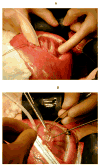Fetal myelomeningocele: natural history, pathophysiology, and in-utero intervention
- PMID: 19540177
- PMCID: PMC3248827
- DOI: 10.1016/j.siny.2009.05.002
Fetal myelomeningocele: natural history, pathophysiology, and in-utero intervention
Abstract
Myelomeningocele (MMC) is a common birth defect that is associated with significant lifelong morbidity. Little progress has been made in the postnatal surgical management of the child with spina bifida. Postnatal surgery is aimed at covering the exposed spinal cord, preventing infection, and treating hydrocephalus with a ventricular shunt. In-utero repair of open spina bifida is now performed in selected patients and presents an additional therapeutic alternative for expectant mothers carrying a fetus with MMC. It is estimated that about 400 fetal operations have now been performed for MMC worldwide. Despite this large experience, the technique remains of unproven benefit. Preliminary results suggest that fetal surgery results in reversal of hindbrain herniation (the Chiari II malformation), a decrease in shunt-dependent hydrocephalus, and possibly improvement in leg function, but these findings might be explained by selection bias and changing management indications. A randomized prospective trial (the MOMS trial) is currently being conducted by three centers in the USA, and is estimated to be completed in 2010. Further research is needed to better understand the pathophysiology of MMC, the ideal timing and technique of repair, and the long-term impact of in-utero intervention.
Copyright 2009 Elsevier Ltd. All rights reserved.
Conflict of interest statement
Figures
References
-
- Mitchell LE, Adzick NS, Melchionne J, Pasquariello PS, Sutton LN, Whitehead AS. Spina bifida. Lancet. 2004;364:1885–95. - PubMed
-
- Hutchins GM, McGowan KD, Blakemore KJ. Spinal dysraphia: not a neural tube defect? Am J Hum Genet. 1992;51:A319.
-
- Botto LD, Moore CA, Khoury MJ, Erickson JD. Neural-tube defects. N Engl J Med. 1999;341:1509–19. - PubMed
-
- Medical Research Council Vitamin Research Study Group. Prevention of neural tube defects: results of the Medical Research Council Vitamin Study. Lancet. 1991;338:131–7. - PubMed
-
- Anonymous. Knowledge and use of folic acid by women of childbearing age – United States, 1995 and 1998. Morb Mortal Wkly Rep. 1999;48:325–7. - PubMed
Publication types
MeSH terms
Grants and funding
LinkOut - more resources
Full Text Sources
Other Literature Sources
Medical


